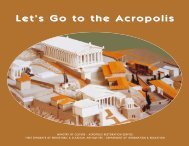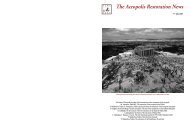τεύχος περιλήψεων - ΥΣΜΑ
τεύχος περιλήψεων - ΥΣΜΑ
τεύχος περιλήψεων - ΥΣΜΑ
Create successful ePaper yourself
Turn your PDF publications into a flip-book with our unique Google optimized e-Paper software.
6TH INTERNATIONAL MEETING FOR THE RESTORATION OF THE ACROPOLIS MONUMENTS - ABSTRACTS 31<br />
THE ACROPOLIS CIRCUIT WALL<br />
M. Korres, Architect, Professor, NTUA. Member of the Committee for the Conservation of the<br />
Acropolis Monuments<br />
The circuit wall, monumental structure of great significance, survive almost in its entirety, but<br />
with numerous repairs from late antiquity to the present.<br />
The most ancient wall, a Mycenaean Cyclopean work, parts of which are still visible dates from<br />
the 13th century BC.<br />
In the 5th century BC, after the victories of the Athenians over the Persians, the so-called<br />
“Themistoclean” or North wall, built almost exclusively of architectural members from the dilapidated<br />
sanctuaries, replaced the corresponding section of the Mycenaean wall, while some years<br />
later (466 BC) the “Kimonian wall” was built outside the Mycenaean wall along the south and the<br />
east edge of the Acropolis rock. During the Frankish domination and the Ottoman rule there were<br />
extensive repairs and additions, while, after the war of independence, consolidation work was<br />
performed on several sections of the wall.<br />
The structural problems of the circuit wall – extensive shifting and deformation, cracks, fractures<br />
and detachment of stone blocks – are due to:<br />
• the aging of the construction materials<br />
• the insufficient bond between added or repaired masses of masonry and the original massive<br />
ashlar masonry behind them<br />
• the powerful thrusts of earth fill behind the wall, combined with seismic actions, and<br />
• the erosion of stone blocks and mortars by humidity and rainwater. This is not only limited to<br />
the surface, but extends to the entire mass, as a result of the water seeping in from outside<br />
and rear.<br />
In recent years (2001-2010), actions aimed at the documentation of the form and state of<br />
preservation of the circuit wall were carried out with funding from the 3rd CSF.<br />
Projects currently under study in order to be implemented with funding from the NSRF are<br />
the following:<br />
a. The arrangement of the course of rainwater over the entire surface of the Acropolis, an intervention<br />
which will contribute to the protection of the walls, as it will eliminate the main cause of<br />
erosion, and<br />
b. The consolidation of the South wall, between the 6th and 7th buttress, as a pilot project.








